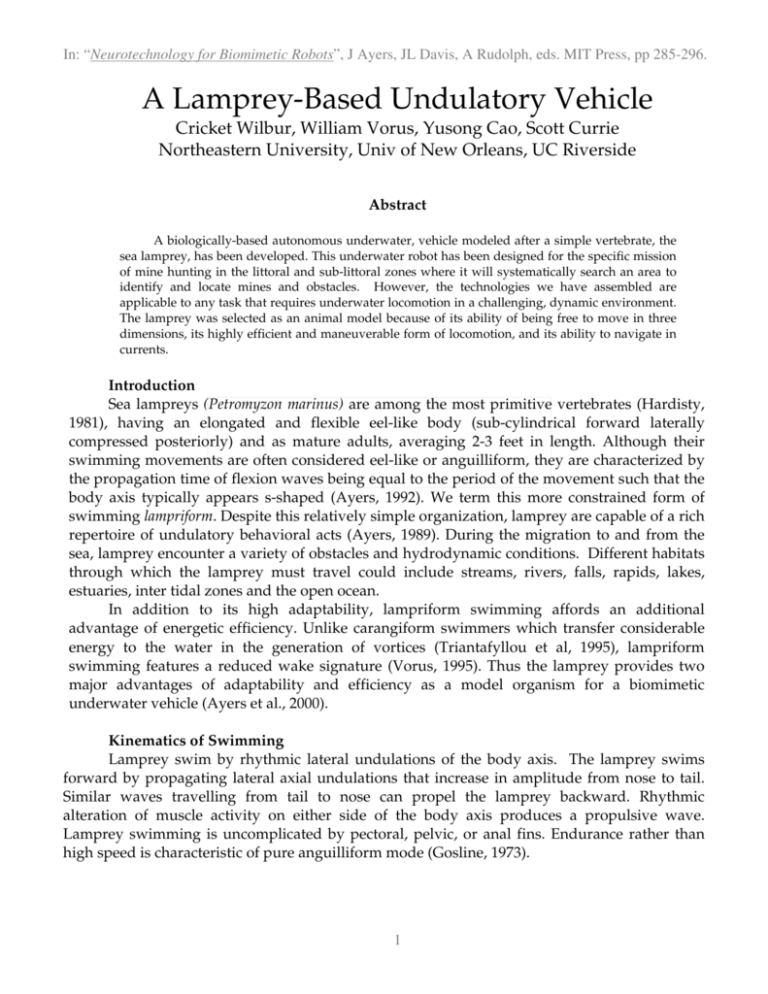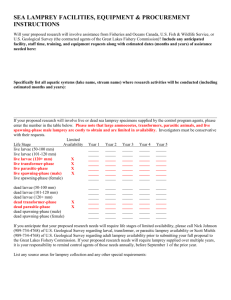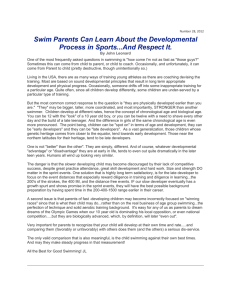Neurotechnology for Biomimetic Robots
advertisement

In: “Neurotechnology for Biomimetic Robots”, J Ayers, JL Davis, A Rudolph, eds. MIT Press, pp 285-296. A Lamprey-Based Undulatory Vehicle Cricket Wilbur, William Vorus, Yusong Cao, Scott Currie Northeastern University, Univ of New Orleans, UC Riverside Abstract A biologically-based autonomous underwater, vehicle modeled after a simple vertebrate, the sea lamprey, has been developed. This underwater robot has been designed for the specific mission of mine hunting in the littoral and sub-littoral zones where it will systematically search an area to identify and locate mines and obstacles. However, the technologies we have assembled are applicable to any task that requires underwater locomotion in a challenging, dynamic environment. The lamprey was selected as an animal model because of its ability of being free to move in three dimensions, its highly efficient and maneuverable form of locomotion, and its ability to navigate in currents. Introduction Sea lampreys (Petromyzon marinus) are among the most primitive vertebrates (Hardisty, 1981), having an elongated and flexible eel-like body (sub-cylindrical forward laterally compressed posteriorly) and as mature adults, averaging 2-3 feet in length. Although their swimming movements are often considered eel-like or anguilliform, they are characterized by the propagation time of flexion waves being equal to the period of the movement such that the body axis typically appears s-shaped (Ayers, 1992). We term this more constrained form of swimming lampriform. Despite this relatively simple organization, lamprey are capable of a rich repertoire of undulatory behavioral acts (Ayers, 1989). During the migration to and from the sea, lamprey encounter a variety of obstacles and hydrodynamic conditions. Different habitats through which the lamprey must travel could include streams, rivers, falls, rapids, lakes, estuaries, inter tidal zones and the open ocean. In addition to its high adaptability, lampriform swimming affords an additional advantage of energetic efficiency. Unlike carangiform swimmers which transfer considerable energy to the water in the generation of vortices (Triantafyllou et al, 1995), lampriform swimming features a reduced wake signature (Vorus, 1995). Thus the lamprey provides two major advantages of adaptability and efficiency as a model organism for a biomimetic underwater vehicle (Ayers et al., 2000). Kinematics of Swimming Lamprey swim by rhythmic lateral undulations of the body axis. The lamprey swims forward by propagating lateral axial undulations that increase in amplitude from nose to tail. Similar waves travelling from tail to nose can propel the lamprey backward. Rhythmic alteration of muscle activity on either side of the body axis produces a propulsive wave. Lamprey swimming is uncomplicated by pectoral, pelvic, or anal fins. Endurance rather than high speed is characteristic of pure anguilliform mode (Gosline, 1973). 1 In: “Neurotechnology for Biomimetic Robots”, J Ayers, JL Davis, A Rudolph, eds. MIT Press, pp 285-296. Figure 1: Analysis of lamprey swimming. (1.1) Graph of the normalized digitized images of swimming in a larval lamprey. A least-squares regression line is fitted to the set of points outlining the body; the line is rotated to become the x-axis. The number to the left of each image is the movie frame number. The interframe interval is ---msec. Analysis of the images presented in (1.1). 1.3 is a plot of the locus of flexion waves versus time, going from nose (0) to tail (100). 1.4 is similar to 1.3 only a least-squares regression line is fitted to the points for each side of the specimen. 1.5 shows curvature of lateral flexions (1/radius of the best-fitted circle to curvature maximum (1.2)) plotted as a function of locus. To quantitatively analyze the undulatory behavior of lamprey, we utilized a computer algorithm (Ayers et al., 1983) that characterizes behavior via stop-frame analysis of video images. Filmed sequences of swimming were digitized frame by frame, and the data points describing the shape of the body axis were smoothed, fit with a 5th order polynomial and the curvature determined along the body axis (Fig 1.1). Undulatory movements are quantified in terms of regions of maximal curvature defined as lateral flexions. Kinematic analysis of the propagation of flexions demonstrates swimming behavior is organized into lateral flexion waves that propagate either rostro-caudally or caudo-rostrally (Fig 1.2, 1.3, 1.4). The time between initiation of flexion waves to the same side define the period of swimming movements, the time for the wave to propagate from nose to tail is the propagation time of the wave. During swimming, the propagation time of flexion waves down the body axis is equal to the period so specimens always maintain an S-shape during swimming (Fig 1.4). 2 In: “Neurotechnology for Biomimetic Robots”, J Ayers, JL Davis, A Rudolph, eds. MIT Press, pp 285-296. Figure 2: (2.1) Plot of the locus of flexion waves versus time. Least-squares regression line is fitted to the points for each side of the specimen. (2.2) Plot of thrust versus time. Thrust is generated when a propulsive wave travels backward over the body at a velocity greater than the speed of forward swimming. Kinematic analysis from thrust experiments on larval lamprey (Fig 2.1) demonstrates lamprey generate a peak of thrust as each flexion wave passes the cloaca (Fig 2.2). The thrust peaks at approximately sixty percent of the body and there are two peaks of thrust for every swimming cycle (Fig 2.2). To evaluate how lamprey swimming movements are modulated by hydrodynamic load, we analyzed high frequency forward swimming of the lamprey in a shallow, wet pan sans water. The analysis of the swimming movements (Fig 3) demonstrate that the active segments during swimming are located in the middle two thirds of the body in the curvature vs locus plot. The fact that the peak of thrust occurs at this same locus indicates that the mid-region of the body constitutes the propulsor for locomotion, and the tail responds passively to hydrodynamic resistance 3 In: “Neurotechnology for Biomimetic Robots”, J Ayers, JL Davis, A Rudolph, eds. MIT Press, pp 285-296. Figure 3: (3.1)Graph of the normalized digitized images of swimming in a larval lamprey. (3.1)Plot of locus of flexion waves versus time. Least squares regression line is fitted to the points for each side of the specimen. (3.2)Plot of curvature versus locus. A behavioral library of the lamprey has been developed by reverse-engineering sequences of spontaneous lamprey action on video. This library consists of a table of timing parameters derived from the quantitative analysis of the various forms of behavior such as swimming, crawling, burrowing, withdrawal, and turning (Fig 4, Table 1). A look-up table generated from the behavioral library forms the basis for the controller of the vehicle. Figure 4: Analysis of normalized digitized images of different lamprey behavior: (4.1)Burrowing, (4.3) Forward Crawling, (4.5) Backward Crawling, and (4.7) Aversive Withdrawal. 4 In: “Neurotechnology for Biomimetic Robots”, J Ayers, JL Davis, A Rudolph, eds. MIT Press, pp 285-296. Behavior Slow swim Average swim Escape swim Forward crawl Backward crawl Burrowing Period (sec) 3.17 1.90 1.52 5.89 10.61 5.66 Phase 0.013 0.013 0.013 0.012 -0.011 0.015 Curvature 0.4 0.37 0.43 1.27 0.96 0.65 Table I. Timing and curvature parameters of different lamprey behavioral acts. Period was normalized to a 1 meter vehicle based on extrapolation from measurements of period as a function of length for smaller lamprey. Phase is the intersegmental delay/period based on a 110 segment lamprey. Adapted from Ayers, 1989. System Design We adapted a conservative command neuron, coordinating neuron, central pattern generator (CPG) architecture to realize a finite state machine that generates an alternating bilateral pattern that propagates along the body axis. This pattern actuates segmental muscles fabricated from shape memory alloy (SMA) arranged on a five-segment undulator formed from a polyurethane “notochord” to generate lateral axial undulations. The actuators are recruited to produce graded force through pulse-width modulation system that recruits proportionally greater martensite state nitinol to the shorter austenite state (Witting, et al., this volume). Control and power electronics are housed in a watertight hull (Fig. 5). The system maintains trim and static roll stability using close-cell foam buoyancy elements and a lead shot “keel” covered by a Lycra ™ skin. We are incorporating a sensor suite including a compass, pitch and roll inclinometers, accelerometers and both look forward and look down sonar range finders. The undulatory vehicle design is a three part system consisting of a rigid hull (~15% of the total body length), a flexible polyurethane "notochord" (~60% of the total body length), and a thin, flexible, passive tail (~25% of the total body length) (Fig 5). This proportionality is based on our observations of the function of the lamprey body axis in the absence of hydrodynamic resistance (Fig. 4). Ten nitinol actuators for locomotion are located along the notochord (Fig 5). Hull: The watertight cylindrical hull of plexiglass houses the electronics (a driver board, a controller board, two constant current boards, a microprocessor (neural circuit-based software)) and batteries. In the lamprey, mass distribution is biased toward the head, 50% of body mass is located in anterior 39% of body (Currie, 1999).Watertight through-hull fittings allow for communication between the actuators and the processors. Axial Beam: The rectangular notochord of polyurethane consists of six teflon ™ vertebrae which attach and pin the SMA actuators along the midline. This arrangement transfers force to the flexible backbone causing it to bend. Each actuator is attached at three points on the notochord to minimize any offset distance from the polyurethane and to control 5 In: “Neurotechnology for Biomimetic Robots”, J Ayers, JL Davis, A Rudolph, eds. MIT Press, pp 285-296. shape changes (Chaudhry and Rodgers, 1991). Buoyancy elements of close-cell foam are placed between the vertebrae and offset from the notochord so as not to impede bending of the polyurethane. These units also help maintain a uniform cylindrical body form. Lead shot weights encased in latex are placed parallel to and below the polyurethane but within the skin to keep the vehicle submerged and to maintain a dorsal side-up orientation. Lycra ™ covers the notochord acting as a skin attached posterior to the hull, continuing the length of the notochord, and terminating between the fins of the tail. Lycra ™ allows water to penetrate, effectively cooling the actuators but protecting them from any flotsam and jetsam in the water column. Figure 5: The Undulatory Robot from nose to tail (average length 36 inches), watertight electronics bay, notochord of polyurethane, tail of fiberglass shimstock. (5.1) Detailed depiction of notochord and tail. Notochord comprised of teflon vertebrae (white), close-cell foam buoyancy elements between vertebrae, lyrca skin, and lead shot encased in latex. Tail: The tail, contiguous from the notochord, is tapered polyurethane overlain by fiberglass shimstock. The shimstock is shaped to resemble two dorsal fins, the rostral fin being much larger than the caudal. This arrangement allows for an increase in axial stiffness (shimstock has a higher Young’s modulus) while maintaining the same bending stiffness thus reducing energy loss in the tail region and inducing the undulatory wave to increase in amplitude as it progresses from head to tail. Actuators: The vehicle is propelled by ten nitinol actuators which consist of a watertight assembly of 0.01” nitinol, etched PTFE™ tubing, stainless steel crimps, 32 AWG lead wire, kevlar line and aquaseal, a waterproof sealant (Witting et al, 2000). This assembly is attached externally to the notochord to induce shape changes in the flexible polyurethane. Operating the actuators in a liquid (H2O) environment allows fast convective cooling necessary for shape control. Maximum cyclic frequency of the actuators is also important to generate the necessary propulsive forces. The SMA actuators are controlled by neural-based circuit software that activates the actuators via pulse width modulation (PWM). Direct current pulses of specific frequencies, amplitude, and duration are used, leading to the definition of a “duty ratio”, defined as the ratio of “on” time to the time between pulses (Furuya and Shimada, 1990). 6 In: “Neurotechnology for Biomimetic Robots”, J Ayers, JL Davis, A Rudolph, eds. MIT Press, pp 285-296. Figure 6: (6.1)Graph of normalized digitized images of swimming in a larval lamprey. (6.2)Analysis of images in (6.1), a plot of thrust versus time. (6.3)Graph of a theoretical wakeless propulsor. (6.4) Plot of thrust versus time. Hydrodynamics We modeled the hydrodynamics of the robot and optimized the hydrodynamics for wakeless propulsion by first comparing lamprey swimming to a hydrodynamic model of a wakeless propulsor (Vorus, 1995, 1996). Comparisons showed correlation between period and propagation time as well as number of peaks of thrust per swim cycle (Fig 6). Figure 7: A plot of the undulation predicted as needed to overcome a drag coefficient of 0.001 at a steady forward speed ratio of 0.9. This is the 3-D ideal displacement shape corresponding to “wakeless propulsion”. 7 In: “Neurotechnology for Biomimetic Robots”, J Ayers, JL Davis, A Rudolph, eds. MIT Press, pp 285-296. A beam model (Fig 7) was then developed for the undulatory robot. This model assumes the neural axis of a section of the composite beam structure (the notochord plus the nitinol (SMA) wires, one on each side of the notochord) is on the side of the notochord where the nitinol wire is not electrically active. The neutral axis switches back and forth from one side to the other side as the beam undulates. Given a displacement of the notochord (e.g. the wakeless motion) and external load, this model can provide the strain and stress of the wire, as well as the stress in the notochord, as functions of time for each section. The beam model was coupled with the 3-D slender body hydrodynamic model for external hydrodynamic load. This coupled model can be used for the prediction and/or evaluation of the external hydrodynamic loads, the internal load (stress), the input power, the propulsion efficiency, and the motion of the undulator. System Integration System integration is a simple input/output (I/O) interface from the processor to the controller. Each of the sensor elements is a switch and each switch is mapped to the bit of a shift register, which the computer reads via a serial line. When a state change occurs in the motor pattern generating circuit, it writes, via a serial line, to a series of shift registers each bit of which is mapped onto the current driver and then to a given actuator. The vehicle can be used autonomously with a small, embedded controller, or be supervised by a laptop for testing. For our first prototype, we concentrated on reproducing the dynamic behavior of lampriform swimming. We developed a multi segment, headless, vehicle comprised of ten SMA actuators. The vehicle, when suspended in the water column and tethered from above, reproduced undulatory swimming motions (Fig. 8). Using the same design, only untethered and suspended in the water column with foam blocks, produced straight-line forward swimming. 8 In: “Neurotechnology for Biomimetic Robots”, J Ayers, JL Davis, A Rudolph, eds. MIT Press, pp 285-296. C D. Figure 8: (8.1) CPG pattern of undulatory swimming. (8.2) Filmed sequences of the undulatory vehicle swimming. Supervised Autonomy Interactions between sensors and commands will be established as releasers to increase the reactive capabilities of the vehicle. In addition, we plan to further formalize categories of modulation for different command systems both in terms of parameteric or “ramp” modulation as well as taxic components. This releaser library associated with segmental reflexes will form the basis of the reactive navigational capabilities of the vehicle and will be based on the behavioral library. These different adaptive behaviors will be implemented sequentially. Many behavioral acts involve basic sequences of more fundamental action patterns and by expanding the library of sequences we can include compensation for current and surge, collisions, disturbances of primary orientation, navigation and searching. 9 In: “Neurotechnology for Biomimetic Robots”, J Ayers, JL Davis, A Rudolph, eds. MIT Press, pp 285-296. The system will face numerous situations where it is presented simultaneously with the sensory releasers for incompatible behavior (e.g. beacon tracking vs. surge compensation). We have established modulation of commands as the basis of choice by elaborating algorithms proposed by Edwards (1991) for crayfish. By establishing a behavior choice hierarchy based on a truth table of releaser combinations we will mediate the behavioral hierarchy. This hierarchy will mediate interactions of a set of modal action patterns and goal-achieving behavior that will form the behavior set of the vehicle. Conclusions This autonomous agent demonstrates the robust locomotion of its biological model. The robotic lamprey emulates the movement of a real lamprey by sequentially contracting its axial musculature. Sensory feedback is used to elicit behavioral changes due to environmental perturbations. For example, the robot will need to increase its swim speed when it encounters strong currents, turn away from or into obstacles and/or mine candidates, and dive and climb according to static pressure changes therefore maintaining a constant depth in the water column. These are all examples of natural behavioral acts of the sea lamprey, Petromyzon marinus. Acknowledgements This work is supported by DARPA/DSO through ONR Grant N00014-98-1-0381. References Ayers, J. (2000) Finite State Analysis of Behavior and the Development of Underwater Robots. In: Artificial Ethology, D. McFarland and O. Holland (eds.). Oxford University Press (in press). Ayers, J. (1992) Desktop Motion Video for Scientific Image Analysis. Advanced Imaging 7: 52-55. Ayers, J. (1989) Recovery of oscillator function following spinal regereration in the sea lamprey. In: Cellular and Neuronal Oscxillators. J. Jacklet, (ed). Marcel Dekker, New York Pp. 349-383. Ayers, J., Carpenter, G.A., Currie, S., and Kinch, J. (1983) Which behavior does the lamprey central motor program mediate?. Science 221:1312-1314. Chaudhry, Z. and Rodgers, C.A. (1991) Bending and Shape Control of Beams using SMA Actuators. J. of Intell. Mater. Sust. And Struct., Vol 2, p. 581-602. Currie, S. (1999) Reverse engineering of lamprey-based undulatory AUV. In: Biomimetic Underwater Robot Program Progress Report Y01Q1-3. Edwards, D.H. (1991) Mutual Inhibition among Neural Command Systems as a Possible Mechanism for Behavioral Choice in Crayfish. J. Neurosci. 11:1210-1223. Furuya,Y. and Shimada, H. (1990) Shape Memory Actuators for Robotic Applications. In: Engineering Aspects of Shape Memory Alloys, Duering etal (ed). Butterworth-Heinemann Ltd. Goseline, William (1973) Functional Morphology and Classificationof Teleostean Fishes. University Press of Hawaii. Hardisty, M.W. (1981) The biology of lampreys. Academic Press. Triantafyllou, G.S. & Triantafyllou, M.S. (1995) An Efficient Swimming Machine, Scientific American, 272: 64-70. Vorus, W. S. (1995) The Concept of a Traveling-Wave Propulsor for High Efficiency and Low Wake Signature. 24th ATTC, College Station, TX. Vorus, W. S. (1996) A Reduced-Wake Marine Propulsor Concept, Annual Report to ONR, Grant Number N0001496-0124. Witting, J. and Safak, K. (2000) Shape Memory Alloy Actuators Applied to Biomimetic Underwater Robots. In: Neurotechnology for Biomimetic Robots. J. Ayers, J. Davis, and A. Rudolph (eds.). MIT Press (in press).. 10




